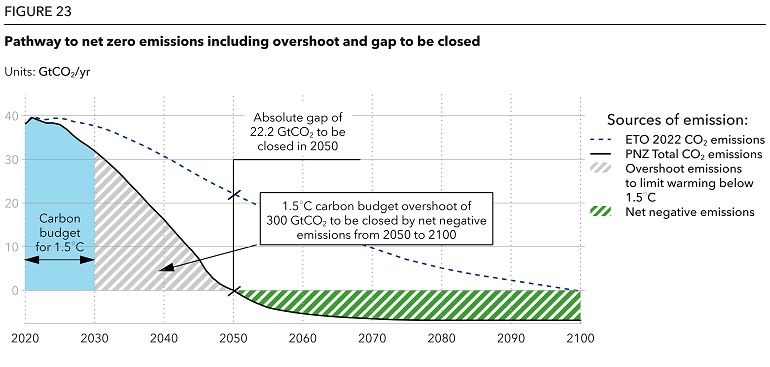This year, our Outlook includes a ‘Pathway to Net Zero Emissions’ alongside our ‘best estimate’ forecast for the energy transition. Put another way, we compare a forecast that we think will unfold with a pathway that we hope the world will embrace.
The gap between the future we see and the future we want
Our ETO forecast has 22 GtCO2 of annual emissions in 2050. Taking those emission to zero is not enough. Even were we to bend the emissions trend to intersect zero at 2050, the 1.5°C carbon budget would be exhausted by 2029 (Figure 23). That means to return to a 1.5°C trajectory by 2100, the cumulative emissions between 2030 and 2050 – an ‘overshoot’ of some 300 GtCO2 — need to be removed in the second half of this century. This involves a massive carbon capture and sequestration effort.

Non-CO2 greenhouse gas emissions
While the majority (~65%) of global warming is associated with CO2, other greenhouse gases, including methane, also need to be controlled. This involves, for example, changes in agriculture or aerosol use. We do not model this but have chosen instead to use the IPCC scenarios in line with ‘very low’ and ‘low’ non-CO2 greenhouse gas emissions estimates in our Pathway. The focus of our Pathway is on CO2 emissions associated with energy use.
Closing the gap
Reaching net zero requires both a deceleration of emitting sources (coal, oil and gas) and an acceleration of low- or zero-emission technologies far beyond our ETO forecast. In addition, a very large scaling up of both carbon capture and storage (CCS), direct air capture (DAC) and nature-based solutions will be needed to remove the overshoot of emissions accumulated before 2050. Up to 7 GtCO2 per year must be removed through to 2100.
In the report, you can read more details about how it is possible to achieve net zero emissions, including details on policy measures, energy demand, technologies, the costs of the transition and pathways for each global region.